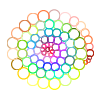Astrology views the heavens from Earth’s perspective. This is called a geocentric view. When a planet appears to be moving backwards in an astrological chart, this is due to the relationship between Earth’s orbit around the sun and the other planet’s orbit around the sun. Retrograde motion is what we observe, not the reality in space. Astrology developed from observation of the sky.
The signs of the zodiac are not an exact match with the constellations of stars in the sky. The circular astrology chart is divided into 12 equal pieces. Each are 30 degrees of the circle. These 12 pieces of the circle each correspond with a zodiac sign.
When the tropical zodiac is used, the signs are set according to the movement of the sun based on our perspective from Earth. In the Northern Hemisphere, Aries starts at the Vernal Equinox, Cancer starts at the Summer Solstice, Libra starts at the Autumnal Equinox and Capricorn starts at the Winter Solstice.
The names of all of the zodiac signs correspond to real constellations that the sun passes through from our perspective here on Earth. The apparent path of the sun is called the ecliptic. These zodiac signs are named for constellations that are on the ecliptic, but the zodiac was created more than 2000 years ago. Due to the wobble of Earth’s axis and a ~26,000 year cycle called Precession of the Equinoxes, the constellations no longer appear to be in the same place as they were when the zodiac was created.
Some astrologers adjust the chart for the new position of the constellations. That is called a sidereal chart.
The actual constellations are not evenly spaced and all the same size. They vary in size. There are also other constellations that are near the ecliptic. The astrological chart is a representation. It is not intended to be a scale model of the heavens.
References
Astronomy Lesson: Precession of the Equinoxes
YouTube video by David Cochrane: Why not Ophiuchus
